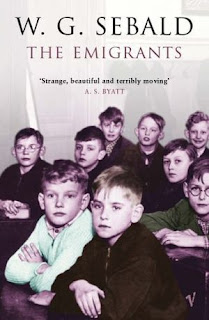I have to give a presentation on this book on Thursday, so I did another marathon Day of Reading today (there've been a lot of those lately). Now I'm too tired to read any of the articles and reviews I'll need to do my presentation properly, but I thought it might help to write down some impressions of the book here while it's still fresh in my mind.
This is not a book I would have finished if it weren't for class, but I'm very glad I did. It consists of four sections, each labeled with a name. They tell the stories (put together by an unnamed narrator whose life parallels Sebald's so closely that I had to look it up to make sure it was really a novel) of four Jewish men who emigrate from Germany to England or America over the course of the 20th century.
The first thing that threw me off was that the sections are not equally weighted. The first is really brief, a glimpse into a life with which the narrator briefly crossed paths. But each section is longer than the one that precedes it, and each story is more nuanced, with more voices adding their perspectives (voices that the narrator gleans from journals, conversations, and interviews). The stories also seem to circle closer and closer to the Holocaust, from the lives it touched to the lives it ended, but the scope of all the narratives together covers both world wars and much other German, English, and American history besides.
What I thought would be a book about the Holocaust turned out to be a book with truly universal insights into the experience of exile. It's about the reasons people leave home and the things it does to them, a topic quite close to me right now.
But this book was also very interesting structurally. The text is interspersed with black and white photographs, which are presented as samples drawn from family photo albums that the narrator came across as he researched various personal histories. This was another reason that I kept thinking the book must be non-fiction, or at least thinly disguised fact. The photos are not cited, so either they really are photos of the people Sebald is writing about, or they are photos of other people, who remained anonymous - a slightly unnerving prospect. I'm very curious to find out more about the sources of these photos in researching book more, but for now the faces scattered throughout the book are a mystery to me.
(This connects to a discussion I had in class yesterday about para-text and the cover design of classic literature - trends like the endless reprints of Jane Austen with painted portraits of anonymous Austenesque women who sometimes have nothing distinguishing in common with the characters in the book. With newer books, I always find myself a bit puzzled by the number of covers with photos of stock models on them, often enough young women with their heads cut out of the frame. I'm never sure whether I'm supposed to imagine the characters as they appear on the cover or not. But Sebald seems to be pushing the envelope by blatently juxtaposing photos and text and seeing what happens. I'm not sure yet exactly what happens, but it was a different reading experience and it challenged my expectation of what fiction should look like.)
The other interesting structural choice is the way in which stories overlap and become confused as you progress through the four sections. This reminded me a lot of what Faulkner does with storytelling and the recollection of the past in Absalom, Absalom!, except that all his narrators circled around one particular family history, whereas Sebald's narrators are mostly all telling their own stories. It's just that those stories start to seem more and more like one story, with landscapes, memories, dreams, and names crossing and recrossing over time, over land, and over a constellation of individual consciousnesses.
I was warned before starting the book that Sebald can be a little dry, and it's true that his prose is nothing special or fancy. But he clearly has a lot of control over language and storytelling. I'd like now to go back and read this in the original German (I didn't realize it was a translation until I sat down to read it) and see what other reflections and echoes the writing might reveal among all the stories. In any case, I liked this book a lot more than I thought I would, and I'm intrigued and ready to learn more when I get to work on my presentation tomorrow.

No comments:
Post a Comment